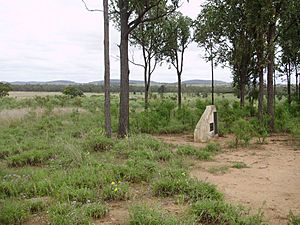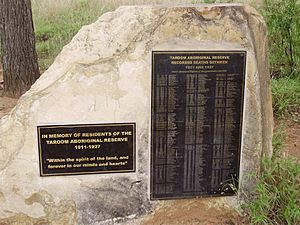Taroom Aboriginal Settlement facts for kids
Quick facts for kids Taroom Aboriginal Settlement |
|
|---|---|

Taroom Aboriginal Settlement site, 2010
|
|
| Location | on Bundulla, Taroom, Shire of Banana, Queensland, Australia |
| Design period | 1900 - 1914 (early 20th century) |
| Official name: Taroom Aboriginal Settlement (former) | |
| Type | state heritage (archaeological, landscape) |
| Designated | 13 May 2011 |
| Reference no. | 602769 |
| Significant components | artefact field, cemetery |
| Lua error in Module:Location_map at line 420: attempt to index field 'wikibase' (a nil value). | |
The Taroom Aboriginal Settlement was a special place in Queensland, Australia. It was a government-run reserve for Aboriginal people. It is also known as Taroom Aboriginal Reserve or Taroom Aboriginal Mission. This settlement was created in 1911 near Taroom on the Dawson River. It was listed on the Queensland Heritage Register in 2011 because of its important history.
Contents
A Difficult History
The Taroom Aboriginal Settlement was set up under a law called the Aboriginals Protection and Restriction of the Sale of Opium Act 1897. This law gave the government a lot of control over the lives of Aboriginal people in Queensland. It allowed them to force Aboriginal people to move to special reserves like Taroom.
Early Days in Taroom
The first Europeans explored the Dawson River area in the 1840s. Soon after, people started setting up large farms called pastoral stations. The town of Taroom grew slowly as a stop between other towns.
As more European farms were set up, there were conflicts with the traditional owners of the land. Many Aboriginal people were harmed or lost their lives during this time. By the early 1900s, surviving Aboriginal people lived in camps around Taroom or on nearby farms.
Why Settlements Were Created
From the 1870s, the Queensland government started setting aside some areas for Aboriginal people. Later, religious groups also set up missions. In 1895, a man named Archibald Meston suggested that the government should take direct control. He believed Aboriginal people should be kept separate from white people.
Meston's ideas led to the 1897 Act. This law gave the government power to remove Aboriginal people from their homes. They could be forced to live on reserves and were not allowed to leave. A "Superintendent" was in charge of each settlement. This law had a huge impact on Aboriginal people's lives.
Taroom was one of the first government-run settlements in Queensland. It was set up on land that used to be part of a large farm. The area was made bigger over time.
Life at the Settlement
In 1911, the first Superintendent, George Richard Addison, arrived at Taroom. He encouraged Aboriginal people from nearby camps to move to the reserve. Soon, people were also moved there from other towns across Queensland. Some were sent because they were sick, couldn't find work, or as a punishment.
By 1912, the settlement had a fenced area for farming. There were also sheds and temporary homes for the Superintendent. Aboriginal people built their own huts using materials like bark, branches, and corrugated iron. These homes often had separate sleeping areas for parents, boys, and girls.
The government wanted the settlements to support themselves. So, Aboriginal people were made to work on the land. They cleared trees, built fences, and grew crops like cotton and corn. They also looked after sheep and cattle. The settlement also became a place where Aboriginal people could be sent to work for others. Men worked on farms, and women worked in homes.
Over time, more buildings were constructed. These included the Superintendent's office, a lock-up (jail), a hospital, and staff quarters. From 1921, they started using mud-bricks to build many structures. These included a "native courthouse," a dairy, a soup kitchen, and a school.
Life on the settlement was very controlled. The Superintendent made strict rules. There was even a small "police force" made up of Aboriginal people. The lock-up was used to punish inmates. However, Aboriginal people did resist. There were frequent escapes, and in 1916, a boxer named Jerry Jerome led a short strike, demanding to be paid for work.
People at Taroom depended on rations for food, like flour, sugar, and meat. They also received blankets and clothes. Sometimes, rations were taken away as punishment. People could also buy extra food from a store if they had their own money. A soup kitchen provided meals for older people and school children.
A school was built, and children were taught basic lessons. The government wanted to move children into dormitories. A girls' dormitory was set up by 1919. Former residents remember it as a low mud-brick building with bunk beds. The dormitory was surrounded by a six-foot fence with barbed wire. This system greatly affected children's connections to their families and culture.
Aboriginal people at Taroom lived in different camps based on their original regions or family groups. Even though they were controlled, some traditional customs continued.
The End of Taroom
In 1922, plans began to move the settlement. This was because a new irrigation project, the Dawson Valley Irrigation Scheme, would flood the low-lying land. In 1926, new land was found near Duaringa. This became the Woorabinda Aboriginal Mission.
All the buildings and equipment from Taroom were moved to Woorabinda. This took 18 months. Aboriginal people from Taroom were forced to walk about 300 kilometres to the new location. The Taroom Reserve was officially closed in May 1928.
Since then, the land has been used for farming. Today, there isn't much left on the surface to show the settlement was there. However, in the 1990s, former residents helped researchers learn more about the site. They shared their memories and helped find important places like the cemeteries.
Descendants of those who lived and died at Taroom still feel a strong connection to the site. They have worked with the current landowners to put up signs and a memorial stone. In 2014, a group of young people walked the same route their ancestors took from Taroom to Woorabinda.
What Remains Today
The old Taroom Aboriginal Settlement site is on a farm called Bundulla. It's next to the Dawson River. There are six main areas that show where the settlement used to be: the Main Settlement Area, Hill Top Cemetery, Lower Cemetery, Settlement Camps, "Home" Orchard, and Communal Sub-Settlement.
Main Settlement Area
This area was the heart of the settlement. Today, there are not many visible signs because the land has been used for farming. However, archaeologists have found old pieces of pottery, glass bottles, and metal items. These small finds help us understand what life was like there.
Hill Top Cemetery
This cemetery is about 300 metres east of the old homestead. It's marked by white-painted rocks. A memorial stone lists the names of people who died at the settlement. Studies show there could be up to 22 graves here, some with multiple burials. Graves were often covered with piles of stones or bottles. You can still see some stone arrangements. Archaeologists have found pieces of glass and pottery here too.
Lower Cemetery
This cemetery is about 200 metres northwest of the Hill Top Cemetery. It's on a sandy ridge near the Dawson River. This cemetery was used between 1918 and 1920, and 72 deaths were recorded during this time. It includes graves from the 1919 "Spanish" influenza epidemic. There are no marked graves, but studies show there are about 24 possible graves. The area is marked by a sign and white-painted rocks. Pieces of glass and pottery have also been found here.
Settlement Camps
North of the old homestead, near the Dawson River, were the camps where Aboriginal people lived. There were five main groups: Gulalee, Burnett, Mixed, Cooktown, and Western people.
- Gulalee, Burnett and Mixed peoples' camps: Many old items have been found here, like pieces of decorated pottery, glass bottles, and metal items. Some interesting finds include a porcelain teacup handle and parts of two ceramic dolls. These show what daily life was like.
- Cooktown peoples' camp: This area is covered in thick bushes, making it hard to explore.
- Western peoples' camp and Goona Gully: This camp was east of the old homestead. Goona Gully was a creek used for washing.
Even though only a small part of these camp areas has been explored, the number of items found shows that many things are still hidden. These items tell us about the homes, food, and personal belongings of the people who lived here.
"Home" Orchard
This was the settlement's orchard, located west of an access track. A small fig tree still grows there from the original orchard. The only other remaining structure from the settlement period is part of the windmill base, made of iron.
Communal Sub-Settlement
This area is about 1 kilometre east of the main settlement. It was an experimental area where families were given small blocks of land to build homes and grow crops. You can still see the remains of at least two "huts" here.
- Hut 1: This hut belonged to Willy Tobane and his family. You can see stone outlines that formed the base of the walls. Pieces of tin and other metal items, like a hatchet head, have been found nearby.
- Hut 2: Next to Hut 1, there's a small group of lime trees. Here, you can find the remains of another hut or house, with a possible fireplace. Items found include a door bolt, a metal barrel hoop, and a horse mouth-bit. Flattened kerosene cans, likely used for roofing, have also been found.
These remains give us clues about the lives of the families who lived in this part of the reserve.
Why This Place is Important
The former Taroom Aboriginal Settlement is listed on the Queensland Heritage Register for several reasons:
- It shows how Queensland's history changed: This site helps us understand how the government controlled Aboriginal people's lives through laws like the 1897 Act. Taroom was one of the first government-run settlements, and it set an example for others in Queensland and Australia.
- It can teach us more about history: There are many archaeological items on the surface and underground at the site. Studying these items can give us new information about how Aboriginal people lived under government control. It can help us understand their daily lives, how they adapted, and how their families and communities were affected.
- It is important to Aboriginal communities: This site is very important to Aboriginal people, especially those whose families were forced to live there. It represents a difficult but important time in Queensland's history. The items found here help tell the stories of those who lived there. The two cemetery areas are especially important to the relatives and descendants of the people who died at the settlement.


